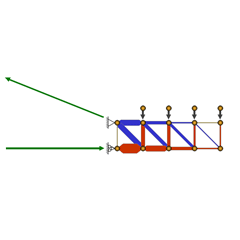
4. Cantilever Truss
 |
4. Cantilever Truss |
| The Screen | The Form Diagram shows a truss that cantilevers
from a wall with its Force Polygon to the right.
The Toggle Switches include ones with which you are
now familiar, plus one new one: |
||||
|
Switch Pin and Roller: Click on it and notice what happens to the reactions and member forces.
|
|||||
| Exercise One | Play | ||||
|
Use the mouse to play with the truss in any way that you like. Explore the possibilities and become accustomed to how all the features work. Try the various toggles. What is the form of the load line on the force polygon? Why? On which side of the load line does the force polygon lie? Is this the same as for a simply supported truss? An arch? A hanging cable? Why are F1 and D8 zero-force members? What happens to F1 when you switch the pin and the roller?
|
|||||
| Exercise Two | Truss Depth | ||||
|
A. Which members of the truss carry the largest forces? Why? Toggle on: Keep Top Chord Level B. Click on the upper left-hand node of the truss. Move it up and down,
and the entire top chord moves with it. |
|||||
|
What is the general relationship between truss depth and member forces?
|
|||||
|
C. Move the entire top chord down slowly, approaching and finally crossing the lower chord. What happens to member forces as the top chord approaches the lower chord? As it crosses the lower chord?
|
|||||
| Exercise Three | Truss Form | ||||
|
Toggles on: Return to starting position, Keep uniform panel spacing, Keep loads vertical, Keep verticals vertical, Keep top chord horizontal A. Make loads AB, BC, and CD each zero. Move the top chord up until you have more or less doubled the depth of the truss. Find a form for the truss such that all verticals and diagonals have
little or no force in them. |
|||||
|
What is the logic of this form?
|
|||||
|
Toggles on: Keep uniform panel spacing, Keep loads
vertical, Keep verticals vertical, Return to starting position, Equalize
loads B. Find a form for the truss such that all verticals and diagonals
have little or no force in them. |
|||||
|
What is the logic of this form?
|
|||||
|
Toggles on: All the above, plus Top-bottom mirror
C. Find a form for the truss such that all verticals and diagonals have
little or no force in them. |
|||||
|
What is the logic of this form?
|
|||||
| Exercise Four | Equilibrium of External Forces | ||||
|
Toggles on: Return to starting position, Extend lines of action A. Make fairly large changes in individual loads, includng sloping some of the loads, and observe the effect of these changes on the lines of action of the external forces. B. Move the supports up and downk continuing to observe the lines of
action of the external forces. |
|||||
| Formulate a general rule about the lines of action of the reactions and the resultant of the loads. | |||||